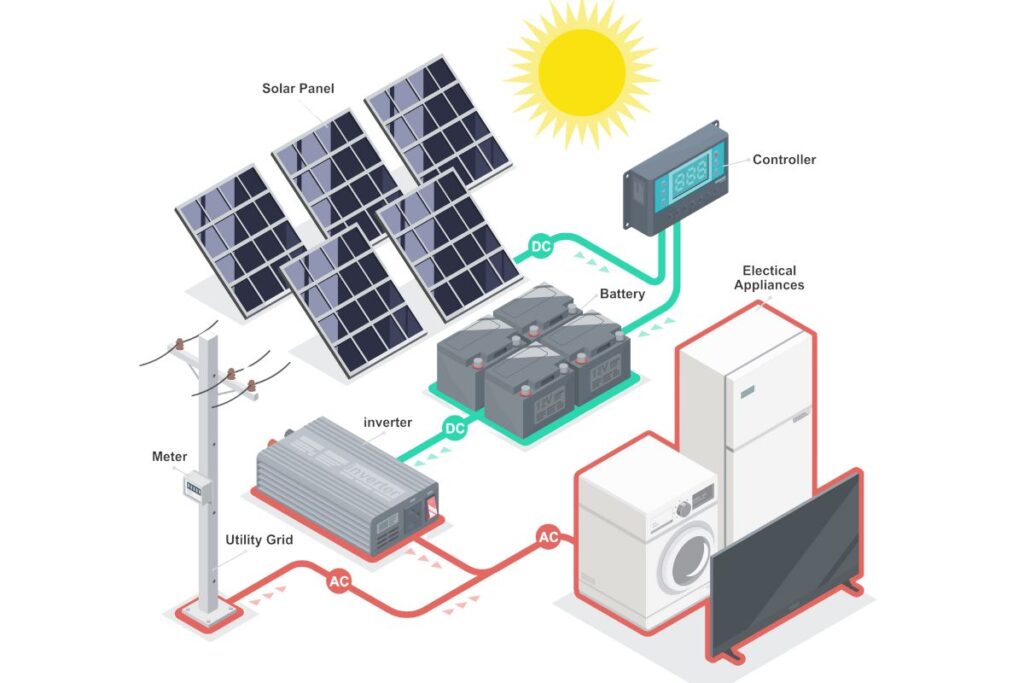Capacity is measured in kilowatt-hours (kWh). That’s the unit that tells you how much electricity your battery holds. So if your battery says 10 kWh, and your house uses about 2 kWh/hour during an outage, you’re looking at around 5 hours of backup. But it’s never that clean. That’s just math, and real life doesn’t always follow math perfectly.
Usable Capacity vs. Total Capacity
This is where most people get tripped up. Batteries have a total capacity and a usable capacity. The total might be 13.5 kWh, but you can usually only use something like 12.2 kWh of that. Why? Because manufacturers build in a safety buffer, the battery doesn’t get overdrained and wear out fast. It’s a good thing, but you need to know it so you’re not overestimating how long the battery will last.

What Affects How Much Capacity You Need?
Some people just want basic solar backup. Fridge, lights, maybe a sump pump or internet router. In that case, you don’t need a huge setup. One battery might be enough, depending on how long you want it to last and how much sun you get to recharge it.
Others want to run the whole house, or at least keep the heat or AC running. That’s when it gets more complicated. HVAC systems, electric water heaters, dryers, and EV chargers can burn through battery capacity fast. If you’re trying to go fully off-grid, or even just ride out a long outage with most of your house still running, you’ll need multiple batteries.
No two homes are the same. No two power needs are the same. That’s why we always start with a conversation.
Average Power Use Examples
Let’s break it down. Here’s what some common appliances use:
- Refrigerator: 1.5 – 2 kWh per day
- Wi-Fi + a few LED lights: 0.5 – 1 kWh per day
- Sump pump: depends, but 0.5 kWh/day is a decent average if it’s not raining
- Furnace fan or boiler pump: 1 – 2 kWh/day
- Air conditioning: 3 – 5 kWh/hour (not per day, per hour)
- Electric oven: 2 – 3 kWh per use
- EV charger (Level 2): 7+ kWh/hour
You add it up, and it’s easy to see how a “just one battery” plan can fall short.

Common Mistakes People Make
1. Assuming the battery will power everything.
Nope. Not unless you paid for a big system and told your installer you wanted whole-home backup. Most setups only support critical loads.
2. Ignoring the usable vs. total capacity.
Like we said above, don’t rely on the number on the box. That’s not what you actually get.
3. Overloading the system.
If you plug in something the battery system wasn’t designed to support, like turning on your central AC during an outage when you only have one battery, it might shut off or fail. You need load management, or just more capacity.
4. Getting a battery that doesn’t play nice with your inverter.
There are compatibility issues between some inverters and battery brands. If you DIY or go with an installer that cuts corners, this is where things break.
When to Install a Battery
If you’re putting in solar now, do it all at once. That’s the cleanest, most cost-effective way to go. We wire the battery and inverter together from the start, plan for backup loads, size everything right, and test it all.
If you already have solar and want to add a battery later, that’s doable, but it depends on your existing setup. We’ve done retrofits that worked great, and we’ve also had to rewire a whole panel because it wasn’t built with storage in mind. Either way, we’ll walk you through it.
And if you’re just here because you’re tired of losing power in storms, yes, you can add storage without solar, but keep in mind it’ll still need to be charged. If there’s no solar, you rely on grid power to fill the battery. So during an outage, you’re limited to what’s in the tank.
How We Handle Capacity Planning
At Lehmann Electrical & Design, we don’t throw one-size-fits-all quotes at people. First, we ask how much backup you want. Then we look at your utility usage, walk through your panel, and figure out the right size. Not just the size that looks good on paper, but one that actually works for how you live.
Right now, most of what we install are Tesla Powerwalls and Enphase IQ Batteries. They’re reliable, easy to monitor, and backed by solid warranties. But the brand isn’t the most important thing; the planning is. Battery size, panel load, inverter match, charging behaviour, all that needs to line up.
What Happens If You Undersize?
You’ll find out real quick. Your system will kick in during an outage and run great for an hour. Then it shuts off because the battery’s dead.
You also might not be able to run what you expected. We had one customer who assumed they could run their well pump and central AC on one battery. They couldn’t. We had to add a second battery and split the loads between two panels to make it work safely.
Undersizing isn’t just inconvenient. It’s frustrating and expensive to fix after the fact. Better to get it right the first time.
Bottom Line
Solar battery capacity is not just a number. It’s your battery backup time. It’s your comfort when the grid goes down. It’s the difference between running your house and running around in the dark.
You don’t need to be an expert in batteries. That’s what we’re here for. We’ll take a look at what you’ve got, what you want to power, and what your solar system can support. Then we’ll give you a straight answer.
If you’re in the Milwaukee or Waukesha area and you’re ready to make a real plan for solar installation, contact us. Let’s get it done right. Or get directions to visit our office.
Need More Info? Read our solar blogs & pro tips
How does the solar heating system work
How is solar heating used in households
Monthly bill for solar panels
Is Solar Energy A Good or Bad Thing to Buy
How Long Does Solar Installation Take
How Much Do Solar Panels Cost In Wisconsin
How Much Does 1 Solar Panel Cost
Residential solar panels cost
